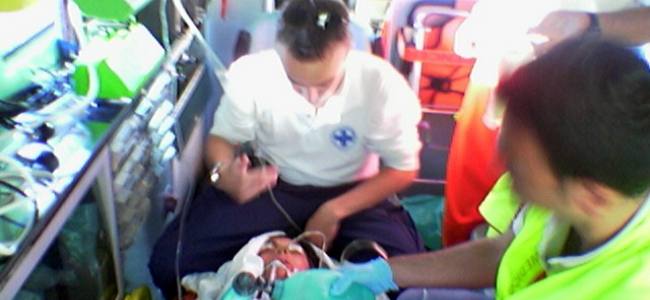
MEDEST118 - When chest compressions and early defibrillation are not the most important interventions in cardiac arrest
Author: Mario Rugna
 The chain of survival is well known and most of us work everyday to spread it’s use at every level. Chest compressions is, along with early defibrillation, the most important and evidence based intervention to save a cardiac arrest patient’s life.
The chain of survival is well known and most of us work everyday to spread it’s use at every level. Chest compressions is, along with early defibrillation, the most important and evidence based intervention to save a cardiac arrest patient’s life.
But there is a group of cardiac arrest patient in whom chest compressions and early defibrillation are not the first and most important intervention to perform.
When a trauma is at the base of a cardiac arrest we know that this patient is either hypovolemic or there is an obstruction at the blood flow at the base of the cardiac arrest, so chest compressions (and vasoactive drugs) are not effective.
We also know that the most common ekg presentation rhythms are Asystole and PEA and early defibrillation is not required.
That’s why when advanced care is performed in traumatic cardiac arrest all the interventions are directed to resolve reversible causes and chest compressions or defibrillation are not indicated.
In brain trauma the most critical phase are the 10 min following the impact. In this phase some critical, but mostly neglected, events occur and the survival of the patients depends on their entity.
Brain impact apnoea and catecholamine surge are the early pato-physiologic processes that determine the life or death of a severely brain injured patient in the first phase of the trauma. Both are proportional to the entity of the impact and can be cause of most of the cardiac arrest in which prehospital providers intervene.
Apnoea is a reaction to the impact and concussion of brain stem in trauma. Apnoea occurs even for obstrution of first respiratory tract due to head position and muscles relaxation following head trauma.
Apnoea cause hypoxia and cell death, but even hypercarbia who leads to vasodilatation and increased blood volume in the brain. All this induce brain swelling and cerebral edema with permanent neurological damage or death.
Catecholamine surge is a reaction of the sympathetic system to head trauma, as to many other stressful conditions, that produces a massive releasing of vasoactive principles who leads to systemic hypertension. This condition determines increasing ICP that, associated with vasodilatation and relative loss of vascular regulatory function, increase brain oedema and neurological damage.
Massive cathecholamine excretion leads also to increasing pre-load and after-load responsible for the secondary heart failure function and acute cardiovascular insufficiency often discovered in massive trauma patients, who develop profound and refractory hypotension in absence of evident, external or internal, blood loss. Other phenomena can also occur as consequence of direct cahecholamine insult as gastric ischemic ulceration, neurogenic pulmonary oedema and myocardial necrosis.
Unfortunately those early phenomena are less likely to be testified by prehospital providers even if an efficient dispatch policy is in place. That’s why there is not much in literature about those topics and all the evidence derives from studies on animal models.
Most of the times this early phase of brain trauma is testified by community responders who has to be aware and instructed that when respiratory or cardiac arrest happens following head trauma, the most effective intervention is opening the airway and supporting ventilation and not performing chest compressions.
Prehospital professionals as also to be aware of the physiologic and clinical implications when comes to deliver Advanced Care. Supporting ventilation and promoting oxygenation and normocarbia are the key features for those patients and have to be prioritized in regard to other interventions.
We also have to remark, when teaching and lecturing in professional and community settings, the difference of priority in interventions between medical and traumatic cardiac arrest.
GoodSam app is a new instrument for EMS and community responders, commonly used for prioritize C interventions (chest compressions and defibrillation) in medical cardiac arrest, but was originally intended to diffuse awareness of brain impact apnoea and to encourage bystanders to perform A (airway opening) and B (ventilation) interventions.
In the future when, thanks to culture and technologies devolopment, everyone at every level will be well conscious about the importance of opening the airway and ventilation in the early phases of trauma the morbidity and mortality associated with head injury will be reduced to a level not yet achieved.
References and resources


